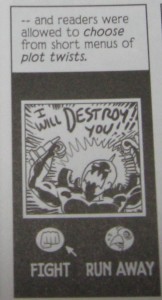Hippasus Gurgles: Go With the Flow
Michael Carlisle examines the world “outside” sequential art to find… more sequential art.
Flow, as a mathematical idea, is based in the notion of time. When looking at a discrete-time flow, we are really talking about a sequence of things, moving in time. Since this is a mathematical idea, though, the sequence can be examined “outside of time,” and so we have a directed sequence, laid out for all to see. When multiple sequences share elements, we have a directed graph. There’s another word for his when content is present: flowchart.
Flowcharts are typically thought of as technical devices used for complex decision-making processes (and so are often considered BO-RING, but lately (last 30 years) they’ve offered writers, game designers, and comics creators a nice device in which to construct work.
Is flowcharting a sequential art?

Share and enjoy.
Michael Carlisle is a mathematics Ph.D. candidate at the City University of New York, where he earned a certificate in Interactive Technology and Pedagogy. When not teaching or researching probability or rambling about dystopian films and surrealist animation, he volunteers with the Sequential Art Collective and New York Center for Independent Publishing.
